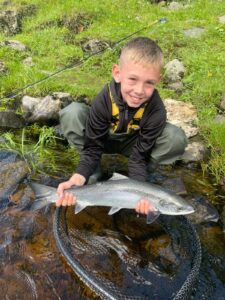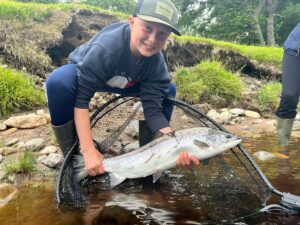Recent years has seen a focus on river temperatures primarily in the context of climate change. Adding to the body of evidence available The James Hutton Institute (JHI) led by Rachel Helliwell (Senior Research Scientist) has recently completed an analysis of river temperature trends in the Spey based on historical angling records from Tulchan Estate. River temperatures have been collected on a daily basis by the estate ghillies with these data recorded in the angling records maintained on the estate. These records extend back over 100 years to 1912.
A factsheet on the analysis, including recommendations can be downloaded by clicking this link River Temperatures Factsheet.
The ghillies temperature records, and a model developed using a range of other datasets, show that the temperature of the Spey has risen significantly in recent decades. Factors contributing to this increase in river temperatures are thought to include rising air temperatures, decreased snowfall, earlier snow melt in the spring & reduced flow.
A range of recommendations to mitigate further rises in temperature are made including river restoration, riparian tree planting, flood management, abstraction control and protection of groundwater. This last point is often overlooked. Groundwater upwellings can provide thermal refugia wherever they occur. Technology such as thermal cameras on drones could now allow us to map where these upwellings occur.
The work of Marine Scotland Science (MSS) in this field is acknowledged , and rightly so. The established a network of temperature loggers across a range of Scottish catchments, including the Spey, by MSS has already produced a number of outputs including the development of riparian tree planting strategies to limit future temperature rises.






7 thoughts on “River temperatures in the Spey: an analysis of long term trends”
Excellent developments Brian, in both research and actions to combat the impacts of climate change on water temperatures. In my experience the most vulnerable areas for producing lethal water temperature for salmon are in the smaller upper catchment tributaries. Many of the moorland streams provide juvenile habitat for salmon and many have sparse shade and tree cover. Any action to provide shade in order to keep small streams water temperature down his good practice at this time of threatened high temperatures.
Does the provision of tree cover not have a detrimental effect on the rivers by reducing water levels as the trees grow?
Hi Dave, Extensive tree cover can reduce water yield through transpiration although it is not straightforward. Tree roots can allow more water to infiltrate to groundwater as opposed to run-off. Catchment scale tree cover can also have a role in natural flood management by reducing peak flows and building productivity – there are positives and negatives. However we are talking here about riparian tree planting i.e. potentially restricted to a 10-20m corridor along the banks. It is only riparian trees that can provide shade, although as Tony points out this needs to be along the wee feeder burns as well as the larger burns and rivers where salmon usually occur.
Thank you for your informative reply Brian. I had in my mind a spate river I fished in N. Ireland in the early 60s. Subsequently the Forestry Commission planted many trees in the catchment area, which in the years following were blamed by many for the rapid run off of the water after a spate. I can not see a 20m corridor making much difference to the water levels, and I wish the MSS great success with their propositions.
Absolutely Tony. We have a lot of information now about where shade can be most effectively planted, and there seems to be a willingness across the community to see action taken. Trees also have an important role in enhancing freshwater productivity. It is interesting to note that SEPA modelling suggests that some of the larger, upland tributaries of the Spey don’t support as many fish as the model predicts. I have responded citing low productivity (based on conductivity and invertebrate sampling) and carrying capacity due to mobility for example, but the counter argument is that that these tributaries are impoverished due to the lack of riparian trees, for example. This is a point.
Brian,
What are the possible downsides to the salmon of higher average water temperatures? I remember Bob Laughton’s Thermal Discharge Project in the 00s which looked at higher temperatures downstream of certain distilleries, fearing to find earlier smolt runs a la Pyrenees and not finding them….
Best wishes,
Anthony
Hi Anthony, good to hear from you. As you know salmon are disappearing from much of their southern range and just hanging on in a few major French rivers, for example. It is generally a cool water species so any uplift in temperature is likely to be detrimental. Warmer water can increase productivity, the Fiddich being a good example where distilleries have elevated temperatures above ambient. This doesn’t seem to be detrimental at present but the Fiddich is well shaded and adult fish have the option of remaining in the main river Spey until the cooler autumn temperatures arrive. There is no thermal barrier in the Spey, as there is in the French/Spanish rivers where salmon must run in the spring before estuarine/lower river temperatures become lethal.
Smolt migration is becoming earlier, 2 days per decade, from memory, which may result in a mismatch between river and inshore marine conditions. It wont be an early smolt run this year though!
ATB
Brian